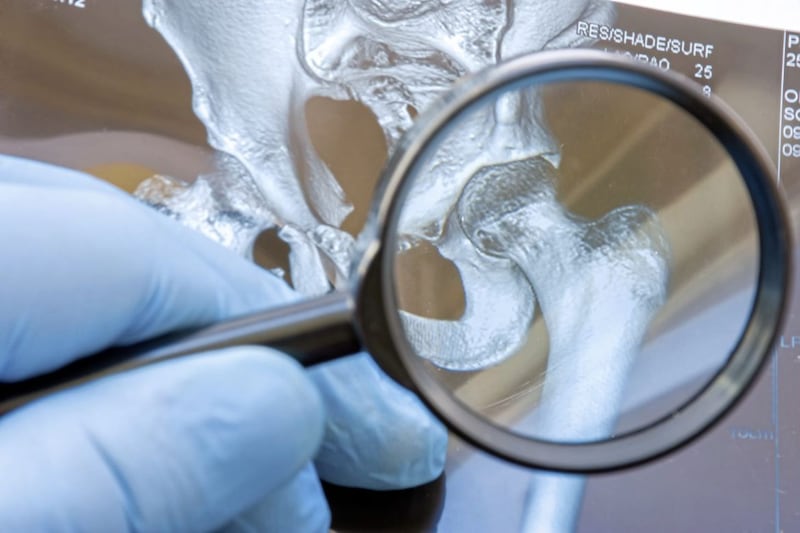AS a hotel chef often on his feet for 10 hours a day, and a keen rugby player, Gareth Dwyer put the constant ache in his buttocks down to his work and lifestyle.
"I played rugby as a prop - pushing against the full weight of the opposing team's scrum - so I thought the pain was just wear and tear from being very active," says 42-year-old Gareth.
"When I was walking, though, I was hunching over like a turtle and the pain could radiate into my hips - the only way I'd get any relief was to put my hands behind my back and press my palms together like Prince Charles does, which my wife took the mickey out of me for."
The backside aches had affected him since his late 20s, and at times were severe enough to wake him in the early hours, but he ploughed on.
It wasn't until the age of 35, when he fell down some steps and fractured his spine, that Gareth learned his aching buttocks were a sign of a form of inflammatory arthritis.
His X-ray and MRI scans showed that the bones in the joints, which join the lower spine to the pelvis, were fused and inflamed.
Gareth also had a positive blood test for the HLA-B27 gene, which predisposes people to developing inflammatory arthritis. This confirmed that Gareth had axial spondyloarthritis (or axial SpA), a form of arthritis that affects the spine and sacroiliac joints.
An estimated 220,000 people in the UK are thought to have axial SpA. It can run in families, and possible triggers for those with a genetic predisposition include infections, stress and trauma.
The conditions that fall under the umbrella include non-radiographic axial SpA (where these joints become inflamed, but this is not visible on an X-ray).
In some cases this can progress to radiographic axial SpA (also known as ankylosing spondylitis), where inflammation causes extra bone to grow, leading to the fusion of vertebrae in the spine.
As well as affecting the ability to do everyday things, including bending, it can impact breathing if the ribcage is affected and the lungs can't expand enough. The inflammation also causes pain and fatigue, and walking can be hard.

Not everyone with axial SpA develops spinal fusion - risk factors include smoking and testing positive for the HLA-B27 gene - but treating symptoms early may help prevent the progression.
Gareth's delayed diagnosis meant that his symptoms had already advanced to those of radiographic axial SpA.
"My posture was affected because of the weakness in my sacroiliac joints, as they couldn't support my spine," he says.
Buttock pain that lasts longer than three months is one of the common symptoms of axial SpA, says Dr Raj Sengupta, a consultant rheumatologist at the Royal National Hospital for Rheumatic Diseases in Bath.
"With axial SpA the main joints involved are the sacroiliac joints, which are over the top of the buttocks, and it's inflammation in these joints that is one of the key features," says Dr Sengupta, who is also a medical adviser for the National Axial Spondyloarthritis Society (NASS) charity.
"The buttock pain radiates from the joints and can alternate from one side to the other - this is a classic sign of axial SpA - or just stay on one or both sides.
"The problem with buttock pain is that it's often confused with sciatica, a common condition caused by irritation of one of the two sciatic nerves that come out of the spinal cord," he explains.
"Sciatica causes pain and tingling in the buttock and radiates down the leg to the feet, but with axial SpA, if you get the buttock pain, it won't radiate right the way down the leg and past the knee.
"Some people are told they have sciatica when they actually have inflammation of the sacroiliac joints caused by axial SpA."
Dr Sengupta says this is one of the reasons why it takes eight-and-a-half years to get a diagnosis on average.
"It's heartbreaking as a rheumatologist to see patients in a clinic who have experienced back pain for years and the cause has been put down to sports injuries or work," he says.
"I'll see up to five of these patients a week. The pain often first occurs when someone is in their 20s, when they are building relationships and a career, and they are left struggling with symptoms.
"This may lead to mental health problems, as well as more damage to their spine."
Another warning sign is back pain lasting more than three months that starts before the age of 40 - back pain that starts after 40 is more likely to be caused by wear and tear - including pain in the lower back that wakes you in the early hours.
One theory for this is that levels of cytokines, compounds that cause inflammation, peak at night. A further warning sign is morning joint stiffness that doesn't wear off after half an hour, but improves with movement and not rest.
Now the charity NASS has launched a campaign to encourage anyone under the age of 40 living with this kind of persistent back pain to see their GP to check if it's axial SpA.
"It's a race against time with axial SpA," says Dr Dale Webb, chief executive at NASS, explaining that the risk of serious and irreversible damage rises the longer someone goes without treatment.
"The good news is that, with the right treatment and care, people can live very well with axial SpA."

Axial SpA is typically treated with biologic drugs that switch off inflammation, says Dr Sengupta.
"These have been around for more than 20 years and were approved to treat axial SpA [in the UK] in 2008. There is a definite halting of progression of the disease with these drugs. This is why it's so important that we diagnose patients as early as possible, identify those who are most likely to progress and treat them appropriately," he says.
Following his diagnosis, Gareth was put on diazepam and the opioid tramadol to help with pain, but within two years he was needing higher and higher doses to keep the pain in check.
He was switched to biologic drugs three-and-a-half years ago and says their effects have been "transformative".
"I now inject myself with a pre-loaded jab once a week and it's been life-changing," says Gareth.
"I've been able to come off diazepam completely and greatly reduce my tramadol dose. It's also let me carry on working as a chef - at one point I thought I'd have to give up as the pain was so bad.
"I use walking poles to keep me upright and improve my breathing. But I can now walk with my hands by my side instead of held behind my back, and I can also be an active dad to my son, and lift him up and play ball games with him - things I had feared I'd never be able to do.
"What scares me, though, is that but for the accident, I could have gone on like that for years, while all the time my spine could have been degenerating.
"I just wish I'd known that pain in your backside can be a sign of a progressive illness and shouldn't be ignored, and then I might not have suffered permanent damage to my joints."
[ nass.co.ukOpens in new window ]
© Daily Mail






